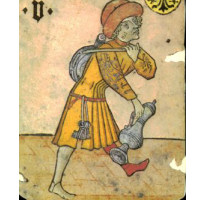Difference between revisions of "Breeches"
m (removed unnecessary category) |
|||
| Line 7: | Line 7: | ||
The spelling britches reflects a common pronunciation, and is often used in casual speech to mean trousers or "pants". Breeks is a Scots or northern English spelling and pronunciation. | The spelling britches reflects a common pronunciation, and is often used in casual speech to mean trousers or "pants". Breeks is a Scots or northern English spelling and pronunciation. | ||
| − | + | [[Category:Garb]] | |
[[Category:European Garb]] | [[Category:European Garb]] | ||
[[Category:Garb Bottoms]] | [[Category:Garb Bottoms]] | ||
Revision as of 17:37, 30 March 2016
Breeches (pronounced [ˈbritʃɪz]) are an item of male clothing covering the body from the waist down, with separate coverings for each leg, usually stopping just below the knee, though in some cases reaching to the ankles. The breeching of a young boy, at an age somewhere between six and eight, was a landmark in his childhood.
A masculine outer garment covering the hips and legs as far as the knee. Until the early Middle Ages these were synonymous with braies (see Braics). During the Middle Ages, and for much of the sixteenth century, men covered their legs with hose (see Hose), but a looser form of breeches was sometimes to be seen. It was from the late sixteenth century that men began to wear breeches and they continued to do so until, in the early nineteenth century, these were slowly replaced by trousers. During this long period many different styles were fashionable but each one was characteristic of a certain age in fullness, length and cut, as well as in fabrics used, so that a specific style of breeches can usually be dated within a decade. In the late sixteenth and early seven- teenth century breeches were full and often padded. The full, loose designs were known as slops and were usually finished at the knee with a tied, fringed sash. Similar were the German pluderhosen and Venetians. These had a bouffant (generally padded) shape which narrowed in pear form towards the knee. Cloak-bag breeches were an early seventeenth-century design. Oval in shape, these were full, unpadded and were drawn in at a little above the knee, where they were finished by decorative points or lace. In the 1630s came the longer full breeches, unpadded and ending below the knee with ribbon loops. Sometimes this style, often known as Spanish hose, was pulled in close at the bottom, sometimes it was left open. Side seams were often decorated by braid andlor buttons.
In the second half of the seventeenth century, boots, which had earlier been so fashionable, were abandoned in favour of shoes as petticoat breeches became the rage in the 1660s (though the fashion lasted from about 1652-75). This was an unusual masculine fashion, either taking the form of a knee-length skirt, like a Scottish kilt, or resembling full, knee-length shorts with the appearance of a skirt. The garment was bedecked almost all over by ribbon loops and bows as well as lace ruffles, and a small apron of ribbon loops covered the front closure. There are several suggested origins for the style. It seems certain that petticoat breeches came from the Rhineland, since the proper name for them was rhinegraves or rhinegrave breeches. This derives from the German rheingrafhose which, in turn, comes from the Rhincland count - Rheingrafen Karl - who wore the costume and from whom it was taken up with enthusiasm by Louis XIV and his court. With the later seventeenth century came the fashion for knee-breeches, which lasted until after 1800. In the eighteenth century, with the advent of the suit - the habit a la francaise - the breeches were often of the same material as the coat. The culottes (as breeches were termed in France) gradually became skin tight. A beautiful fit was obtained by cutting on the bias and extending the back to a high waistline. In front, the material which stretched across the thighs was sewn or buttoned on to a wide basque which hugged the waist. At the bottom. the culottes, which earlier had been concealed by stockings rolled up over the knee, were now pulled down over the stocking and buttoned or buckled there. In the late eighteenth century breeches or culottes were still fitting but worn longer to well below the knee. This was a fashion which stemmed from France, doubtless influenced by the climate of opinion en- gendered during the Revolution and the symbolism of the trousers worn by the Sansculotte movement (see Sansculotte, Trousers).
The spelling britches reflects a common pronunciation, and is often used in casual speech to mean trousers or "pants". Breeks is a Scots or northern English spelling and pronunciation.
